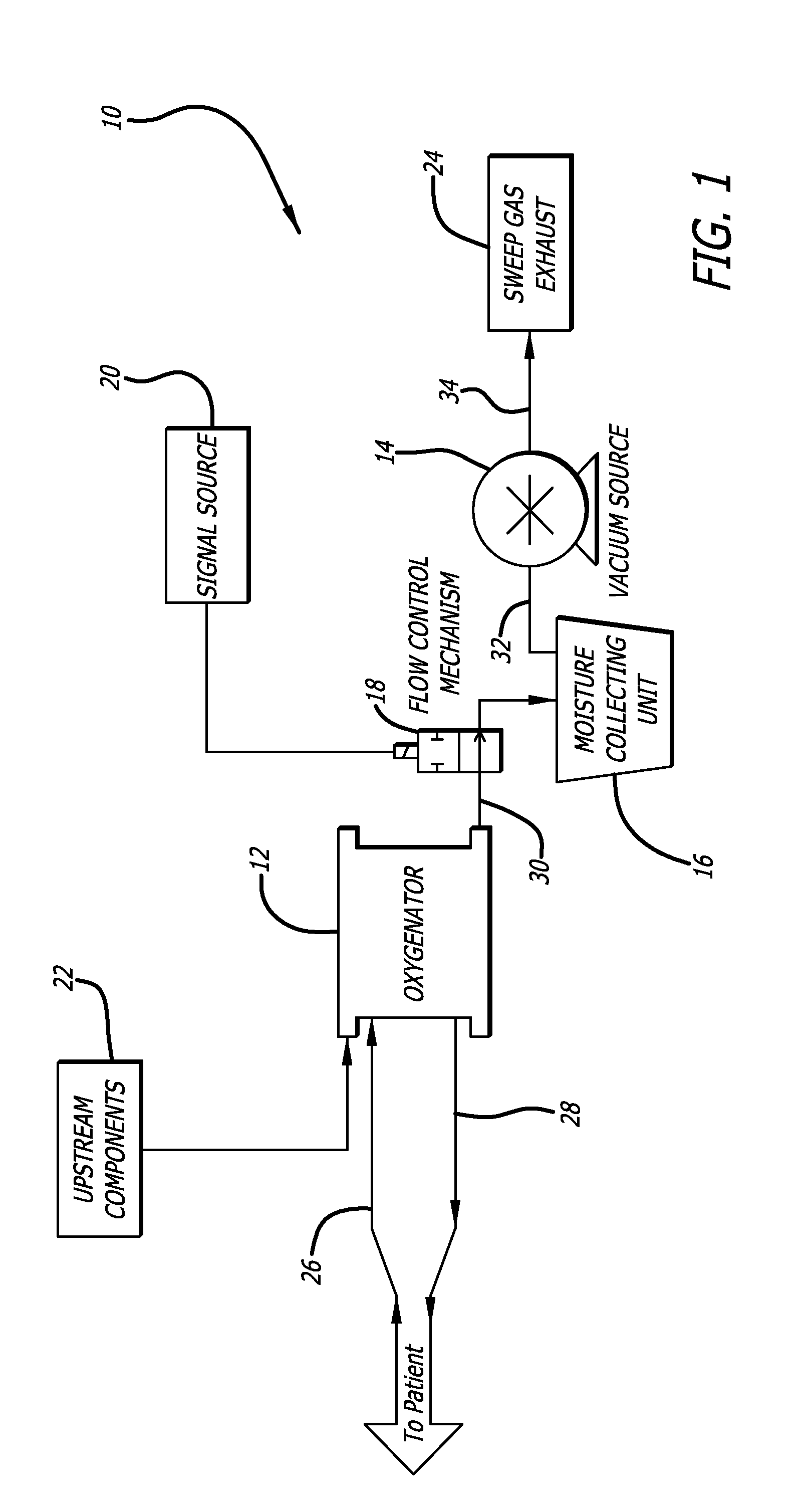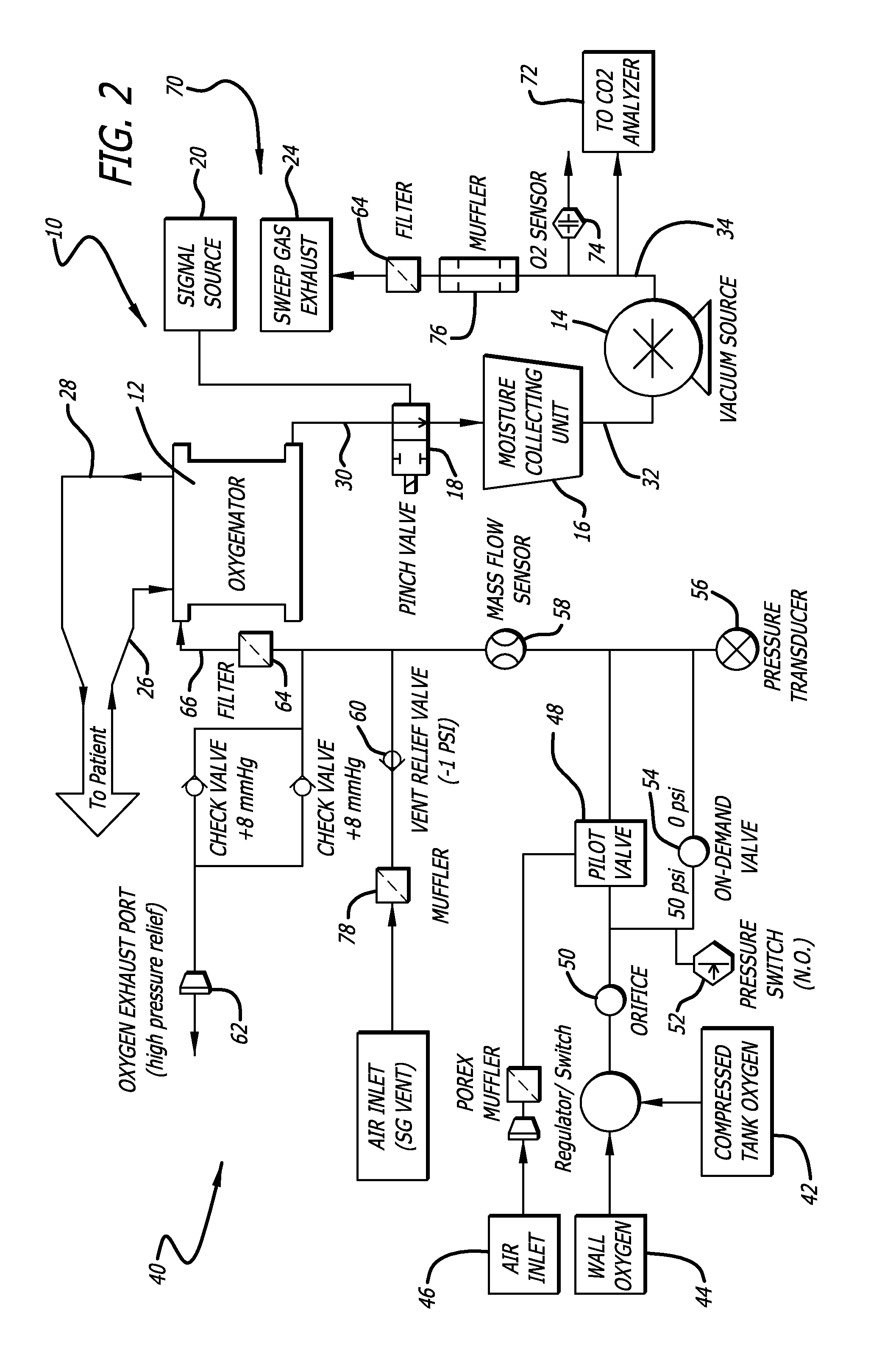[0009]The present invention is directed to a method and system for improving the
gas exchange properties of
oxygenators which utilize hollow
fiber membranes for removing
carbon dioxide and / or adding
oxygen to a patient's blood via
extracorporeal circulation. The present invention improves the gas exchange properties by intermittently removing moisture buildup from the fibers of the oxygenator. The present invention utilizes negative pressure, or a vacuum, to draw the sweep gas into the oxygenator and a moisture purging system which intermittently removes any moisture from the oxygenator. The present invention accomplishes this without the need to increase the pressure of the sweep gas as it enters the
fiber bundle of the oxygenator. The moisture purging system of the present invention generates the “cough” that removes moisture from the oxygenator without the need to increase the pressure of the sweep gas entering the oxygenator. Accordingly, there is no
increased risk of
forming gas emboli in the blood flowing through the oxygenator since the sweep gas is being drawn into, rather than being forced or driven into the oxygenator. This removal of accumulated moisture from the oxygenator can be performed intermittently to insure that there is little possibility of any appreciable moisture accumulating in the fibers for a prolonged period. As a result, the gas exchange rate for the oxygenator should not be affected by moisture accumulation in the oxygenator during usage.
[0010]The present invention utilizes a source which will draw the sweep gas into the oxygenator utilizing a vacuum (negative pressure). In one aspect of the present invention, a
vacuum pump, for example, could be used to draw the sweep gas into the oxygenator, rather than positively pushing sweep gas into the oxygenator. The vacuum source would be connected to the sweep gas exit port of the oxygenator to draw, rather than drive, the sweep gas through the fiber bundles. As a result of utilizing a vacuum to draw the sweep gas into the oxygenator, rather than using a
positive pressure source which pushes or drives the sweep gas into the inlet port of the oxygenator, there is little chance of the sweep gas permeating the fiber membrane into the blood flowing through the oxygenator. Therefore, there is little chance of gas emboli being formed in the blood being returned to the patient during the moisture purging steps described below. In one aspect of the invention, a source for the sweep gas (usually oxygen or air) would be connected to the gas inlet port of the oxygenator. The moisture purging system of the present invention would be connected to the sweep gas outlet of the oxygenator and will create a build up of negative pressure that, when released, will cause a sudden rush of sweep gas though the oxygenator, effectively removing all accumulated moisture.
[0012]The moisture purging system further includes a flow control mechanism associated with the moisture collecting unit and the oxygenator. In one aspect of the present invention, the flow control mechanism can be a simple
pinch valve which opens and closes the conduit (for example, flexible tubing) connecting the moisture collecting unit to the oxygenator. When the flow control mechanism is placed in the open position, the sweep gas will freely flow through the conduit connecting the oxygenator to the moisture collecting unit as it is being drawn by the vacuum source. When the flow control mechanism is placed in the closed position, fluid communication between the moisture collecting unit and the oxygenator will be temporarily closed. The flow of sweep gas through the oxygenator also will be temporarily stopped. The vacuum source, however, will continue to evacuate any sweep gas contained within the moisture collecting unit, which causes a build up of high negative pressure within the moisture collecting unit itself. After a
short duration, the flow control mechanism will be placed back into the open position. When this occurs, sweep gas is again drawn into, and rushes through, the fibers of oxygenator at a
high velocity to fill the vacuum created in the moisture collecting unit. The velocity of the sweep gas flow will increase with higher vacuum achieved in the moisture collecting unit. This increase in the velocity of the sweep gas will cause any moisture accumulating in the fibers of the oxygenator to be removed and drawn into the moisture collecting unit with the sweep gas. As the vacuum developed in the moisture collecting unit increases, better moisture purging will take place. As a result, the fibers of the oxygenator can be maintained clear of moisture accumulation during usage.
[0013]The flow control mechanism can be connected to a
signal source designed to open and close the fluid path between the oxygenator and the moisture collecting unit. The period that the mechanism remains open or closed could be easily programmed into the
signal source to activate the moisture purging system. Since it usually takes a bit of time to accumulate moisture in the fibers of the oxygenator, the moisture purging system will usually remain in the open position in which sweep gas is being continually drawn through the oxygenator. The
signal source could then provide a signal to the flow control mechanism to assume the closed position, and will dictate the duration that the flow control mechanism will remain in the closed position. After that period is reached, the
signal source will move the flow control mechanism back to the open position to purge the moisture from the oxygenator. Again, the duration that the flow control mechanism remains in the open or
closed system can be determined and easily adjusted using controls associated with the
signal source. The described system is therefore capable of removing moisture from the oxygenator without increasing the pressure within the fibers of the oxygenator and without compromising patient safety.
[0014]The moisture purging system of the present invention can be used on a number of different oxygenators which utilize hollow fiber membranes for removing carbon dioxide or adding oxygen to a patient's blood via
extracorporeal circulation. The present invention can be utilized with a number of different systems which supply the necessary sweep gas to the oxygenator. Likewise, the moisture purging system of the present invention can be connected with additional
instrumentation which can, for example, analyze the oxygen /
carbon dioxide content of the sweep gas as it exits the oxygenator.
Feedback loop controls could be associated with such equipment and the
signal source to adjust the timing of the intervals when the flow control mechanism is placed in either the open or closed position.
 Login to View More
Login to View More  Login to View More
Login to View More 


